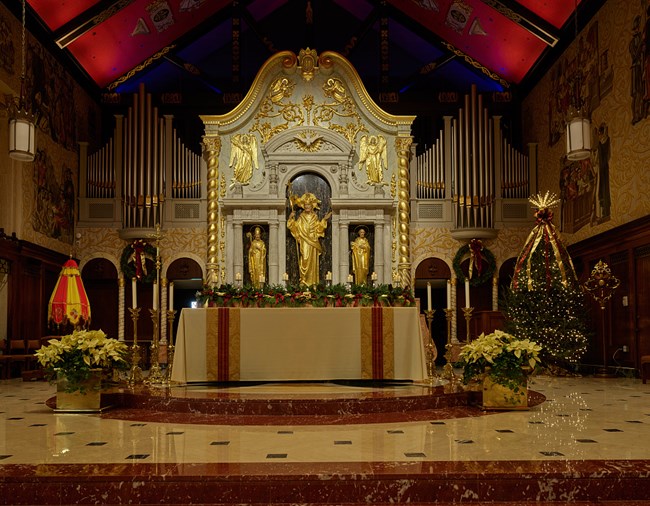Last updated: February 21, 2023
Article
Building and Rebuilding the Cathedral of St. Augustine

Photograph by Wikimedia user Carlstak
The Cathedral of St. Augustine, the center of America’s oldest Catholic parish, is located in the heart of the nation’s oldest continuously occupied European-established city. Spanish explorer Don Pedro Menéndez de Avilés founded and established the city of St. Augustine in 1565. Sailing from Cádiz, Spain, Menéndez spotted the east coast of Florida on the feast day of Saint Augustine of Hippo, August 28, so the settlement’s name became San Agustín (St. Augustine) in his honor. At the landing on September 8, 1565, the Spanish held a celebratory Mass and thus began the establishment of the church. Most of the Spaniards were sailors and had little to no experience in architecture, but they rapidly constructed a simple and not very sturdy church from a variety of materials.
War broke out between Spain and England in 1585. The following year, Englishman Sir Francis Drake sailed to North America and captured St. Augustine, pillaging and burning the city to the ground, including the church. Citizens were able to recover and quickly rebuild the city. The new church they constructed used straw and palmetto, which would not last long in Florida’s humid climate. Soon, another fire, this time a natural one, destroyed the church again. They then built a third church of timber, a supposedly more permanent material, which deteriorated from lack of proper maintenance, climatic conditions, and the increasing numbers in the congregation. The British governor of colonial South Carolina, James Moore, led an invasion of St. Augustine in 1702, destroying this church.
St. Augustine went without its church for over 90 years. Multiple attempts to rebuild it all failed even after the king of Spain sent a large amount of money to rebuild the church in 1707. The colony was in such poor shape that the money never made it to the church but instead went to purchase goods and to pay for soldiers and public officials. With no place left to worship, the local people celebrated Mass in La Soledad Hospital’s chapel until 1763. That year, the Spanish ceded Florida to Great Britain as a part of the First Treaty of Paris, which ended the French and Indian War.
Catholicism began to die out in Florida after the English arrived until a new workforce of Minorcans, Italians, and Greeks arrived to the area in 1767 and reinvigorated the religion. In 1784, the English ceded Florida back to Spain, thus encouraging the revival of Spanish Catholicism. Two years later, the Spanish royalty requested construction of a new church. Laying the cornerstone in 1793, the Spanish completed a new church four years later in the Spanish Mission style.

Retrieved from Library of Congress. Photograph by Carol M. Highsmith
In 1870, the church had its status raised to the level of Cathedral with the creation of a new Catholic diocese in St. Augustine. The St. Augustine Cathedral suffered damage from a fire on April 12, 1887, but its exterior shell was salvageable. A national appeal raised funds to rebuild the interior. The congregation hired the prestigious New York City architect James Renwick, Jr. to work on the burned building.
The project included enlarging the Cathedral and constructing a transept, which gave it a more European look. Renwick devised a roof system that relied on timber but decided to decorate the timbers and leave the ceiling exposed. He also added a Spanish Renaissance-style bell tower. The addition of the bell tower was not a unique idea; Spanish mission churches out west already had bell towers. The exposed bell out front became a symbol of the Spanish mission, influencing the decision to build a bell tower at the Cathedral of St. Augustine. The Cathedral has four bells, one salvaged from a previous church and thought to be the oldest bell in the United States. Another bell came from a British cathedral, a history with some irony due to that empire's repeated destruction of the St. Augustine church.
To celebrate the 400th anniversary of St. Augustine’s founding, the congregation renovated the Cathedral and added the Blessed Sacrament Chapel dedicating the renovated church on March 9, 1966. Ten years later, Pope Paul VI raised the status of the Cathedral to a minor basilica, the 27th American church awarded that honor.
Visitors to St. Augustine Cathedral can see the church restored to look as it did in the late 1700s. Most of the Baroque façade is original to that period. Inside, beautiful oil paintings that are copies of those located in the Vatican’s Pauline Chapel are on display. Victorian stained-glass windows and marble altars are on view throughout the Cathedral. Touring the building or sitting in on a Catholic Mass in the Cathedral takes visitors back to the times of Spanish rule in St. Augustine.
